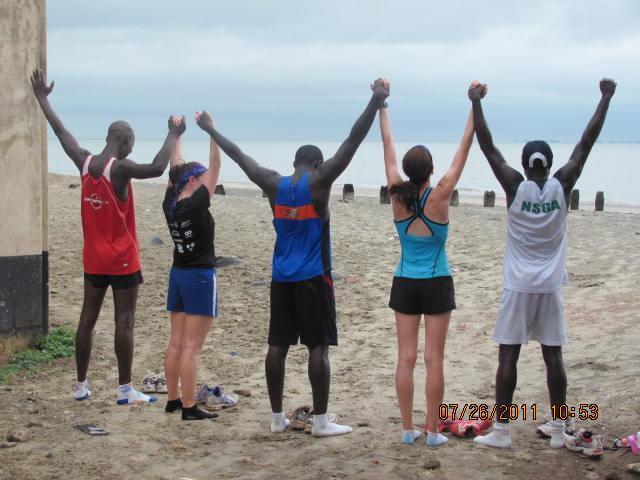This week, a friend named Doreen invited me to speak with a group marathoners that she coaches about being mentally strong. This is my third visit to this marathon training clinic, part 1 is on this blog here.
Doreen requested that I talk about what helped me manage running all the way across a hot African country: 25km for 17 days in row in 2011. I talked about how I stayed strong, how I managed the heat and how I dealt with setbacks. I have been at this for 12+ years and I also talked about how, en route to becoming mentally stronger, you learn some of this over and over.
The Heat
It was really hot in The Gambia in 2011 when I ran all the way across the country. Like between 37 and 42 degrees hot. But the heat never impacted my running performance because I chose not to let it. The heat just was. I needed to run whether or not it was hot so I just didn’t think about it.
Sometimes after I explain this, people will say, “oh, so the heat wasn’t that bad.” I explain that wasn’t it at all. It was very hot; 42 degrees is very hot. It’s 107.6 degrees Fahrenheit. It was so hot that my hair and skin were almost always dry despite sweating like crazy. It was so hot that 2 pairs of my sneakers melted because the heat made the asphalt so hot.
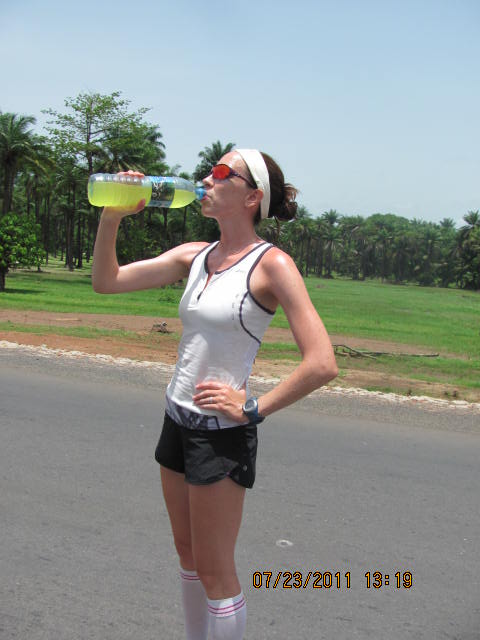 I couldn’t do anything about the heat. I had a 25km goal each day, regardless of the air temperature. There was so way I was going to stop running. I had no control over the heat. But I did have control over how I responded to the heat. I coped with the heat by not even considering the heat. I didn’t think about it. I didn’t talk about it. I didn’t know the actual temperature, ever. I never considered that the heat might cause me to stop running because stopping was never in the realm of options.
I couldn’t do anything about the heat. I had a 25km goal each day, regardless of the air temperature. There was so way I was going to stop running. I had no control over the heat. But I did have control over how I responded to the heat. I coped with the heat by not even considering the heat. I didn’t think about it. I didn’t talk about it. I didn’t know the actual temperature, ever. I never considered that the heat might cause me to stop running because stopping was never in the realm of options.
Managing 42 degree heat was all about being strong. Plus I was doing everything possible to allow my body to run well in the heat in terms of nutrition and hydration. But, the bottom line was that the human body will allow you to be strong enough if you want it bad enough and if you will it to be strong enough.
So in terms of how that relates to your marathons: your body is strong enough to do your task. It’s strong enough to run the race time that your training has prepared you for. But you need to be confident and chose to believe that you are strong enough. You have to believe in your strength so much that stopping isn’t an option. I know you are strong enough. Your coach, Doreen, knows that you are strong enough. You need to choose to be strong enough and you need to tell yourself over and over in training. You practice your fueling and your form in strides and your pre-race meal. You absolutely need to practice this too!
Some Science: The Psychobiological Model of Endurance
Matt’s Fitzgerald’s book “How Bad do you Want It?” is a great read on becoming mentally stronger, or more “mentally fit” as he writes. He details Samuel Marcora’s “Psychobiological Model of Endurance.” In this model, decisions about pacing or quitting are taken by the conscious brain and these decisions are primarily based on conscious sensation of how hard the activity is: perception of effort. The job of the muscles is to perform. The job of the mind is to cope. Muscles can perform only to the degree that the mind can cope. In running, successful coping is any behavior, emotion or thought that leads to better performance. Coping is any response to discomfort that favourably changes your relationship to the perception of effort. These are factors that can increase the amount of perceived effort that an athlete can/will tolerate.
Fitzgerald’s book shares with us that to be the best runner that you can be, you need to become really good at coping with usual forms of discomfort/stress that running dishes out. My coping skills of motivation/determination and belief in myself helped me coped with the heat in the Gambia. If you really want it, you will tolerate a greater amount of discomfort. I really wanted to reach the Atlantic Ocean in Banjul. Here are some more.
Familiarity Breeds Comfort
The way to get really good at coping with the discomfort of distance running is to experience it.
In one of my favorite running blogs, “The Logic of Long Distance,” blogger Jeff writes:
“Familiarity breeds comfort, and though I feel pain, I get better at controlling my reaction to it.”
This was a very true phenomenon on my road to Banjul in 2011.
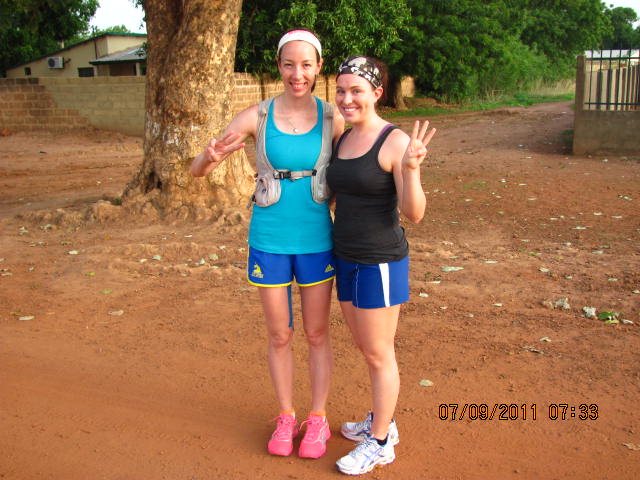
In my assessment, the worst that I felt was beginning the first 20km run on Day 3. It was my 3rd day of running 25km per day. I had put 50km on my legs in the past 48 hours. When I began to run that day, I was stiff and sore from toes to hips. Surprisingly, my shoulders ached from being in runner’s stride for so many hours out of the previous 48. That morning, I knew that the stiffness and soreness would fade within 2 or 3km as my forward running motion circulated fresh blood to my objecting muscles. I did feel better. By km 3, I was running comfortably.
Looking back, although I name Day 3 as the worst day for my legs, I think that I actually felt like that every single day. It was never dangerous pain. I hurt in an acceptable way. My legs were fatigued from hard work. Some mornings, I was still sore after 2km so I would run for 15 minutes and then do a full set of track warm up drills. I would feel better after that. But from Day 3 on I expected it; I was prepared for it; I knew it would go away; and I knew that I would run through it no matter what.
By Day 13 of 17, my quads and hip flexors were tired and remained tired until I reached the ocean. Actually, by Day 13, I was sore at rest pretty much all the time and it was hard to sleep but it was a happy, hard work sore and I just accepted it.
All of the discomfort that I felt on the road to Banjul was both familiar and expected. The human body can do it. But you need to be prepared for it and be ready to run through it.
During your marathon, be prepared to receive messages from your body and your brain. These messages will tell you: “We are tired. We hurt. We want to stop.” Be prepared to deal with these messages and push through it. Feeling bad is ok. Has this happened to you in training? Good! It’ll breed familiarity. You are learning that feeling bad is ok and you building coping skills to cope with this. Hold onto that experience as evidence that you can get through it.
Then learn this again: Feeling Bad is Ok
In 2011, I think that I would have told you that I was very good at being prepared for and dealing with discomfort. But this year, in 2016, I can tell you that it’s a lesson that I’ve been relearning over and over again. All I would have to do is flip through the blog posts that I wrote this summer season and that lesson would be glaring at me.
The lesson that I’ve relearned the best this season is “Don’t give up because it’s hard. It’s hard because racing is really damn hard.” It’s hard because it’s hard. Not because you suck or you can’t do it.
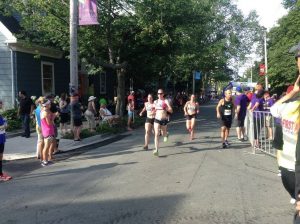
At the Penguin 5km Race this spring, I gave up a little because it was so hard. When it got hard, I thought that I was totally sucking and had already blown my goal. At that instant, I hadn’t blow my goal at all. But at the finish line, I missed my goal by 5 tiny seconds. Maybe because I believed that I sucked long enough to give up just a tiny 5-second bit. I was better the next race. The next two races were awesome.
My closing race this summer was a half marathon. I got down to 18 km and there was information from somewhere in my brain telling me this is really hard and I was sucking and I felt like I was losing my pace. But this time, I knew that I wasn’t losing my pace. This time, I knew that it felt so tremendously hard because it was so tremendously hard. My coach’s instructions were to drop the hammer and leave it all out there for the last 5km. This time I looked at my watch for proof and there I saw proof: 4:04/km. I stayed on. I didn’t give up even a second. I crossed the line as planned at 1:26:58.
Your goals might not come in 5 seconds increments. Your goal might be tied to time at all, it might be to finish feeling happy. But this is still relevant. Racing doesn’t really get any easier. You just get faster and the poles move up. Maybe I am faster but I feel the same as you do when you are racing your hardest. My 1:26 is your 1:46 or 1:56. Feeling bad is ok. If you want it bad enough, you will endure some discomfort or suffer for it and you can do that best by learning that feeling bad is ok.
Hopefully you’ve brushed up against this in training. I’m an online coach and when my runners email me their weekly update and say, “I felt like I was going to die on the last intervals!” I say, GOOD! Because now you’ve learned that you don’t die. You got through it. Stronger. Remember how you got through it.
So be prepared for it to feel bad and for that to be ok and for you to keep running. Practice this in training. Pay attention to when you feel like you are going to die in a quality session and then don’t. Memorize it so you can hold it up like evidence in your race.
How to Cope with Feeling Bad: Figure out What Works
I’ve already covered that you are going to feel bad. Setbacks pop up. In the Gambia, I ran 25km for 17 days and the remarkable days were the ones that were unremarkable.
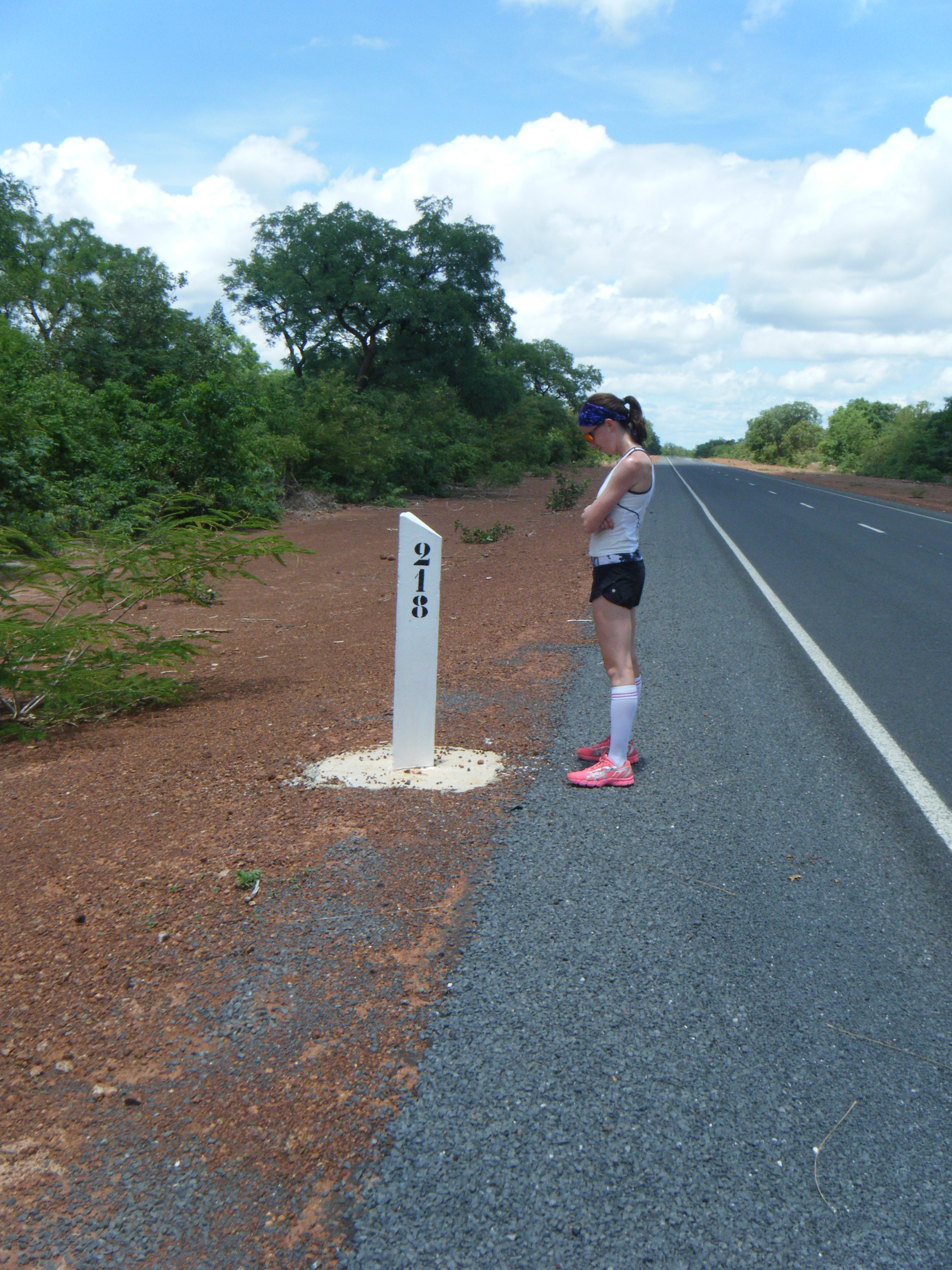 I managed many of setbacks and moments of feeling bad:
I managed many of setbacks and moments of feeling bad:
- On Day 5, my guts refuse to accept Gatorade and energy gels during the first 20km run
- On Day 6, kilometer markers appeared on the South Bank Road, announcing that I was 280km from Banjul, filling me with waves of anxiety about how far I had to run.
- On Day 7, my setback was emotional. It was my birthday and I was lonely and missed my family
- On Day 9, I poisoned myself with water from a tap and had terrible cramping diarrhea and couldn’t take a lot of Gatorade or gels. It was hot. I was getting weak.
- On Day 13, my support person Ashley was sick in bed and the rest of the team was down. I had an intense and persistent “I don’t want to run” feeling. My brain was trying desperately to hit the “off” switch to shut down the running.
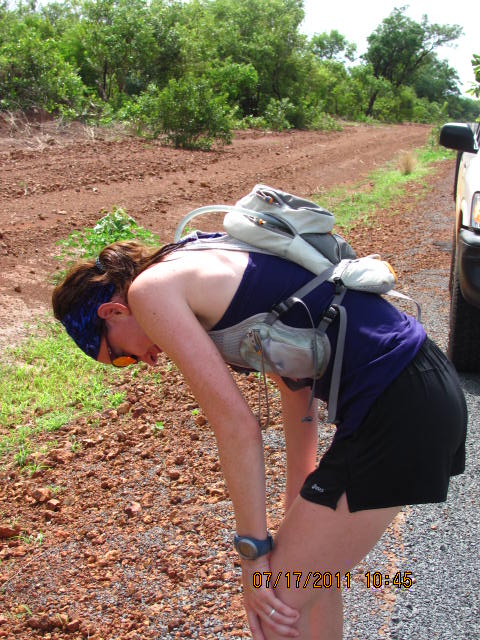 On Day 15, we didn’t have enough food and I was hungry. We were in place that food was hard to get. I was cranky. My chest chafed really badly. Then our destination disappeared and I had to run an unexpected extra 5km pushing my daily total to 30km while hungry with a chafed chest.
On Day 15, we didn’t have enough food and I was hungry. We were in place that food was hard to get. I was cranky. My chest chafed really badly. Then our destination disappeared and I had to run an unexpected extra 5km pushing my daily total to 30km while hungry with a chafed chest.
I managed all of those setbacks. With coping skills. Unfortunately, there isn’t a roadmap of what coping skills to use (I sure would like to write that book!). We each need to figure this out on our own. All I can do is share what worked for me.
Mental focus was one of things that I relied on most.
When my chest chafed, I hurt a lot. I knew that I couldn’t give in to hurting. If I knew that if I could focus enough just on running, I could get the pain under my sports bra to go away. If I can focus hard enough on just running, I have the ability to just run and tune everything else out. So that’s what I did. This is also what helps in races when I start counting the km markers too closely which is rarely helpful behavior. I just run.
Mental focus got me through my emotional setbacks too. On Day 7, I told Kebba who was running next to me that I wasn’t going to talk to him for the next 20 minutes. “I’m not happy or sad, I’m just running.” Kebba replied, “That’s ok, I have many exciting thoughts in my head!” I zoned out and just ran. I made my mind go blank. Running was all I was focused on. I recovered.
Visualization helps too. On Day 13 when I didn’t want to run, I used my “rope.” There’s a saying to tie a figurative rope to the runner next to you and let him/her pull you along. That day, I looked at the kids who were running with us and I tied my rope around them and I did it.
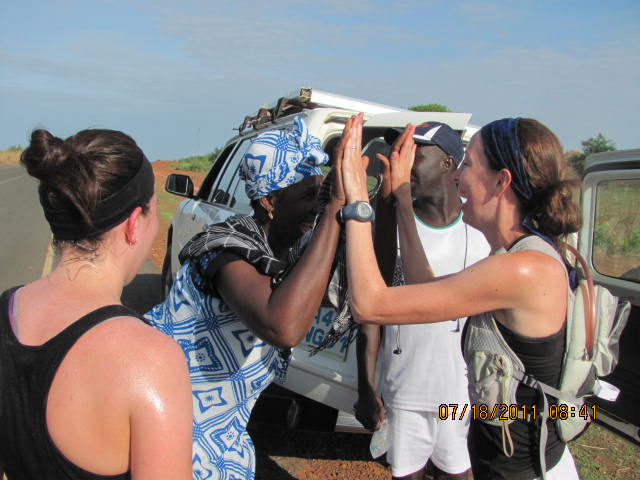 Distraction: Focusing on the kids, mamas and soldiers were hugely helpful for me. My legs matched my mood out there on the road in The Gambia. When a convoy of soldiers saluted me, it was impossible not to have my spirit soar. When my spirit soared, so did my legs.
Distraction: Focusing on the kids, mamas and soldiers were hugely helpful for me. My legs matched my mood out there on the road in The Gambia. When a convoy of soldiers saluted me, it was impossible not to have my spirit soar. When my spirit soared, so did my legs.
When 70 year old Mamas in rice fields hugged me, high fived me, laughed with me, expressed their gratitude to me, I would run away from them with legs that felt brand new.
I would hurt or be tired. But each time I was joined by children, all traces of fatigue and pain vanished. I was running for these kids, for NSGA programs that impact their lives. With them running next to me, I felt like I could fly.
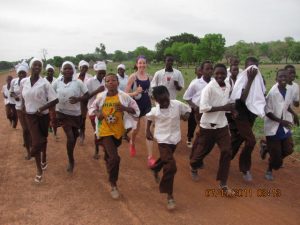 Mantras: I used mantras: short sentences repeated over and over again. Mantras allow me push the sensory data from my legs out of my head. I concentrate only on the words. Sometimes my mantras are prepared. Sometimes they are whatever pops into my head. On Day 16 in the Gambia, my legs were tired and I was hurting. A young boy, Molamin was running with us. I was watching him run and repeating to myself, “Run for him. Run for him.” During the 9km he ran with us, I remember feeling like I hurt everywhere and nowhere all at once. My mantra made those 9km disappear easily. I once ran almost an entire Boston Marathon repeating, “Mommy. Mommy.”
Mantras: I used mantras: short sentences repeated over and over again. Mantras allow me push the sensory data from my legs out of my head. I concentrate only on the words. Sometimes my mantras are prepared. Sometimes they are whatever pops into my head. On Day 16 in the Gambia, my legs were tired and I was hurting. A young boy, Molamin was running with us. I was watching him run and repeating to myself, “Run for him. Run for him.” During the 9km he ran with us, I remember feeling like I hurt everywhere and nowhere all at once. My mantra made those 9km disappear easily. I once ran almost an entire Boston Marathon repeating, “Mommy. Mommy.”
If your race is in North America and not on the South Bank Road in The Gambia, you may not be quite a lucky as I was in terms of content for distraction and mantras. But there are a lot of joyful sights on the sidelines of a North American race. There are people cheering. There are volunteers spending their day with you, handing you water. There are police officers holding back traffic and recognizing your effort with a smile. There are folks who have put care into coloring signs. Your friends and family may be there. Think about what you’ll find on the race course and plan to use these small pieces of joy to lighten your feet with distraction and mantras.
In a long race like a marathon feeling bad and some struggle is inevitable. I’m not suggesting that my exact strategies will work for you. I discovered that they worked for me by paying attention to my training and learning what helps when I struggle. I ask the runners that I coach to write down three positive things that they will say to themselves during their race. Remember, coping skills that help you deal with the discomfort will decrease your perceived level of effort and enhance your performance. So pay attention to what works and put that in the pocket of your short shorts for use when you need it. Bring it with you to the race. But practice it first in your training. You can’t bring something with you that you don’t own. Own your mental focus tools.
Be Determined
Maybe some of this is helpful, maybe not. It helped me accomplishment a huge and amazing goal in West Africa. It has helped me perform well here this summer on Run Nova Scotia’s Performance Series.
When I went to The Gambia, I wasn’t not an overly special or talented runner. I was not an elite or a professional. I was just a regular girl with some talent who worked really hard for many months to prepare for a really difficult challenge. I was determined and motivated to reach my goal no matter what.
I wish you the same determination and motivation.
